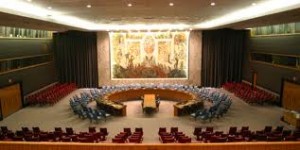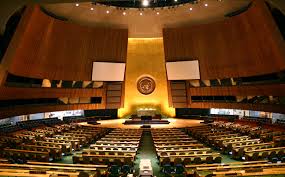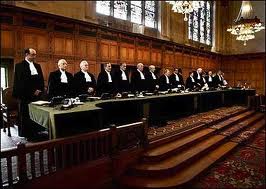The United Nations is a rich and complex organization with decades of history. The nature of its politics, history, and capabilities are all interesting to study. However for the purpose of successfully competing in a Model UN conference, there are some basics everyone should know. This article will provide general knowledge of the six different organs of the United Nations and their functions. This is by no means an in depth analysis of individual bodies and their powers, but most of this information is necessary to function in a conference setting.
1. United Nations Security Council (UNSC or SC)
Alas, the Security Council. It has been called many things in the past from the brains of the UN to the elite club of the superpowers. How I like to think of the Security Council is as the Executive Branch of the United Nations. Notice that the SC is the Executive Branch and not the President. Instead of a singular person, it is a collection of fifteen members that have been delegated the task of responding to crises effectively and efficiently. Additionally, the SC is also the body of the UN that can levy economic sanctions and approve Peacekeeping forces. All other organs of the United Nations refer their resolutions TO the Security Council. The General Assemblies can only advise the SC and that is why all resolutions created in the GA’s are worded as recommendations. The SC can typically write resolutions with stronger operative clauses and may condemn actions by certain countries and organizations. The SC is organized around five permanent members: China, France, United States, Russia, and Great Britain. These five, as winners of World War II, are afforded greater power and relevance in the SC. They retain permanent membership and are often called the Permanent Five (P5 for short). One other significant power is that the P5 are each afforded a veto vote. So for any resolution to pass through the SC, it must not be vetoed by any of the P5 and receive a majority affirmative vote. Alongside the P5 is the ten rotating seats. These ten temporary seats are each elected by the GA for a term of two years.
Specifically for conferences, sometimes the SC will not use formal Rules of Procedure and may use a perpetual moderated caucus. This is where the general form for discussion is a moderated caucus of indeterminate length. Additionally, some conferences don’t write formal resolutions for the SC and instead issue action orders. Action orders are like short resolutions consisting of just operative clauses. This is typically done in crisis SC in order to facilitate faster response time to incoming information.
2. General Assembly
The General Assemblies are where most of the representation and discussion of the United Nations occur. There are a large number of different General Assemblies each tasked with a specific field of discussion. The most popular are GA Plenary, GA1 (Disarmament and International Security), GA3 (Social, Humanitarian, Cultural), and GA6 (Legal). The GA’s are typically characterized by formal resolution writing. These committees have the most number of delegates and as such, bloc formation is especially relevant here. There is usually less floor time for any given delegate because of the sheer number of participants. Instead, a delegate must find other ways to make themselves heard either through note passing, unmoderated caucuses, or effective questioning. One thing to remember is that GA resolutions are all taken as recommendations. The resolutions are not binding and must be approved by the SC for binding action. So instead of authorizing a peacekeeping force, the GA can only recommend that the SC authorize a peacekeeping force.
3. International Court of Justice (ICJ)
The ICJ is just what it sounds like, the judicial organ of the UN. It is located in The Hague, Netherlands. This makes it the only organ of the United Nations which has its seat outside of New York. Make sure to distinguish the ICJ and International Criminal Court from each other. Both exist but the ICJ is the one affiliated with the UN. I like to think of the ICJ as an analog of a Supreme Court for obvious reasons. As a delegate for ICJ, there are two options, judge or lawyer. As a judge, you will listen to the cases brought forth by litigants and discuss them. One important procedural matter for the ICJ as a judge is the selection of the chief judge in the very beginning of committee. In my experience, it is typically the head judge that wins a gavel so this selection is extremely important. As a litigant, a delegate must prepare cases and bring them forward at conference. It works in the manner a typical courtroom may work. The ICJ deals mostly with the legality of UN issues. This organ may be referenced by other resolution and has particular ties with GA6 (Legal) on specific legal matters.
4. Economic and Social Council (ECOSOC)
As the principle organ of the UN that coordinates economic and social initiatives, ECOSOC is run similarly to the GA’s. The format is that of typical resolution writing and it has limited power. ECOSOC typically focuses on long term economic and social issues. It is a council where only a certain number of countries are present at any one time. Each member only gets one vote unlike the UNSC where some members have more power than others.
5. Trusteeship Council
This council is nonexistent as of now. They were tasked with overseeing the independence and self governance of 11 Trust Territories. As of the mid 1990’s all the territories had achieved self governance or independence. The Trusteeship Council had particular relevance during the decolonization of Africa. Since then, the council has become largely inactive.
6. Secretariat
There is not much to mention about the Secretariat from a delegates point of view. For the UN, the Secretariat keeps the UN running and deals with procedural matters. The face of the UN is the Secretary General, currently Ban Ki-Moon. However, the Secretary General does not have the same powers the President of a country may have. His/her responsibilities include mostly procedural matters. Yet, the nature of the Secretary General largely contributes to the effectiveness of UN decisions as they are the peacemaker between countries. The Secretary General is also always present at UNSC meetings. From a delegate’s standpoint, just make sure to impress the Secretariat. Treat them politely and with respect for all the work they’ve put into the conference and for the awards they give.
This has been a short overview of the different organs of the United Nations from past to present. While specialized delegates may never need to know more in depth information about other committees, it is always advantageous to demonstrate your knowledge of the UN by referencing certain organs in resolutions. Overall, the UN bodies are all largely intertwined. By understanding the layout and responsibilities of each body, a delegate may develop a more mature understanding of the UN and its separation of powers that will really set them apart.




